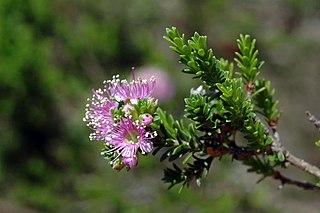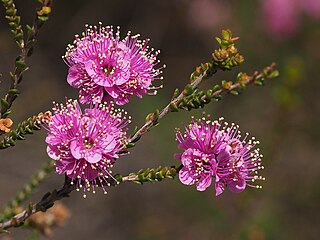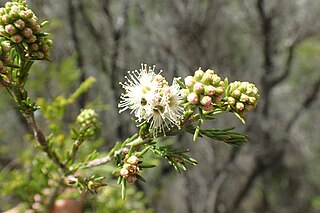
Kunzea salina is a species of flowering plant in the myrtle family, Myrtaceae and is endemic to the south of Western Australia. It is a low, spreading, densely branched shrub with leaves mostly arranged in opposite pairs and usually two sessile pale pink to white flowers arranged at the base of new shoots. It only grows near the edge of certain salt lakes.
Kunzea glabrescens, commonly known as spearwood, is a flowering plant in the myrtle family, Myrtaceae and is endemic to the south-west of Western Australia. It is a large shrub with leaves and flowers similar to those of K. ericifolia but has differently shaped bracteoles. It is often common in wet areas around Perth.

Kunzea jucunda is a flowering plant in the myrtle family, Myrtaceae and is endemic to the south-west of Western Australia where it occurs on sandy or rocky soils of undulating plains. It is similar to Kunzea affinis and where the ranges of the two species overlap, hybrids occur.
Kunzea acuminata is a flowering plant in the myrtle family, Myrtaceae and is endemic to the south-west of Western Australia where it has a restricted distribution. It is a shrub with a few spindly branches, silky leaves and spherical groups of pink flowers on the ends of the branches.
Kunzea affinis is a flowering plant in the myrtle family, Myrtaceae and is endemic to the south-west of Western Australia. It is a shrub with many branches, small, crowded leaves and pink, five-petalled flowers in early spring.

Kunzea ciliata is a flowering plant in the myrtle family, Myrtaceae and is endemic to the south-west of Western Australia. It is a spreading shrub which typically grows to a height of 0.8 to 1.5 metres and blooms between October and November producing pink flowers.
Kunzea cincinnata is a flowering plant in the myrtle family, Myrtaceae and is endemic to a small area on the south coast of Western Australia. It is a shrub which typically grows to a height of 0.6 to 1 metre and blooms between September and October producing pink to red-purple flowers.

Kunzea clavata, commonly known as the Torbay spearwood, is a flowering plant in the myrtle family, Myrtaceae and is endemic to a small area on the south coast of Western Australia. It is a shrub or tree, typically with many branches and grows to a height of 2.5 to 4 metres. It blooms between September and October producing yellow flowers.

Kunzea micromera is a flowering plant in the myrtle family, Myrtaceae and is endemic to the south west of Western Australia. It is a small, sparse shrub, similar in some respects to K. micrantha but has shorter, more rounded sepal lobes. It produces groups of pink flowers on the ends of a few long shoots in spring.

Kunzea rostrata is a species of flowering plant in the myrtle family, Myrtaceae and is endemic to an area along the south west coast of Western Australia. It is a shrub with small, mostly elliptic leaves and with groups of between mostly eleven and fifteen rose pink flowers mainly on the ends of branches that continue to grow after flowering.

Kunzea similis is a species of flowering plant in the myrtle family, Myrtaceae and is endemic to a small area along the south coast of Western Australia. It is a shrub with linear to lance-shaped leaves with a single vein, and spherical groups of between four and ten pink flowers on the ends of shoots.

Kunzea pauciflora, the Mount Melville kunzea, is a species of flowering plant in the myrtle family Myrtaceae, and is endemic to a small area on the south coast of Western Australia. It is a shrub with the stems densely branched near their ends, linear leaves and one, two or three pink flowers near the ends of the branches but usually only at the top of the shrub.
Kunzea praestans is a flowering plant in the myrtle family, Myrtaceae and is endemic to Western Australia. It is an erect shrub with sessile leaves and groups of about fourteen to twenty pink flowers in more or less spherical groups on the end of the branches.

Kunzea spathulata is a species of flowering plant in the myrtle family, Myrtaceae and is endemic to a small area in the south west of Western Australia. It is a tall shrub with erect, much-branched stems, linear leaves and more or less spherical groups of yellow or yellowish green flowers.
Kunzea aristulata is a flowering plant in the myrtle family, Myrtaceae and is endemic to a small area of New South Wales. It is an erect, spreading shrub similar to Kunzea rupestris but is distinguished from it mainly by the shape of its leaves. It is only known from a remote area north of Yerranderie where it often grows on cliff edges.
Kunzea axillaris is a flowering plant in the myrtle family, Myrtaceae and is endemic to a small area of New South Wales. It is an erect shrub or tree with linear leaves and white flowers which are arranged singly in leaf axils. It is only known from the ranges on the north coast.

Kunzea obovata is a flowering plant in the myrtle family, Myrtaceae and is endemic to eastern Australia. It is a spreading shrub with unusually-shaped leaves and clusters of pink to purple flowers. It is restricted to northern New South Wales and south-eastern Queensland.
Kunzea caduca is a plant in the myrtle family, Myrtaceae and is endemic to Queensland. It is a spreading shrub with linear to lance-shaped leaves and groups of white to cream-coloured flowers on the ends of all the branches from late winter to early spring. It is only known from a few locations and only conserved in the Castle Tower National Park near Gladstone.
Kunzea juniperoides is a flowering plant in the myrtle family, Myrtaceae and is endemic to a small area of New South Wales. It is a small shrub with narrow leaves and small groups of white flowers near the end of the longer branches. It is distinguished from similar kunzeas by the large number of scale-like perules and bracts surrounding the groups of flowers.

Kunzea occidentalis is a flowering plant in the myrtle family, Myrtaceae and is endemic to a western New South Wales. It is a shrub with narrow leaves and small groups of white flowers on leafy side-branches. It is distinguished from the similar Kunzea ambigua by the flanges on the sides of its young branches.












